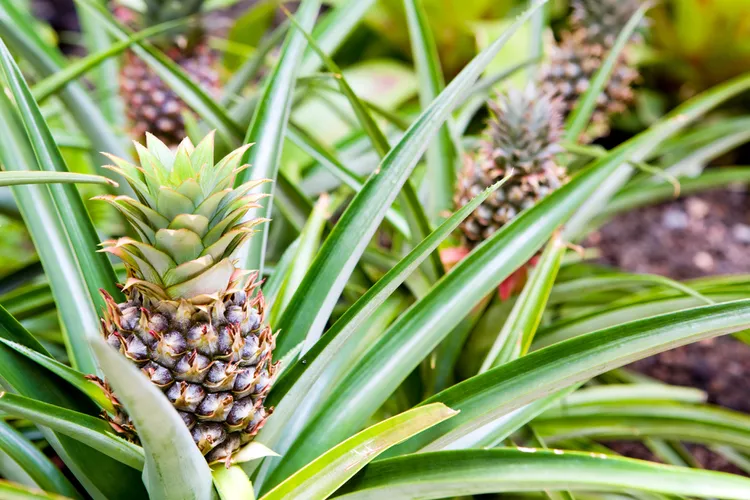How to Plant a Pineapple to Grow Delicious Fruit

Pineapples look tough and spiky on the outside, but inside, they're packed with sweet, juicy goodness. Most pineapples you find in a grocery store come from tropical regions. Gardeners in other zones can only grow indoor potted pineapple plants and move them outside for the summer. If you're curious about how to plant a pineapple, it's easy to start by planting a pineapple top. With a bit of luck and the right growing conditions, your plant might flower and produce pineapple fruit. All you need is a ripe pineapple with a healthy, leafy top. Here's what you need to know about how to plant a pineapple.
According to the ASPCA, small bites of ripe fresh pineapple fruits are safe for cats and dogs. Just don't give them unripe or canned fruits.
Where to Plant a Pineapple
U.S. gardeners in USDA Zone 11 or 12 can grow a pineapple in a sunny location outdoors, but everyone else must either grow it as a houseplant or in a container that can be moved outside in warm weather and back inside to a protected area for the winter. If you live in a tropical place, plant the stem right in a garden bed with soil that drains quickly.
When and How to Plant a Pineapple
Plant the top cut from a grocery store pineapple any time of year if it will be growing indoors or in the spring for outdoor planting. Use a sharp knife to cut the crown, or leafy top, from a fresh, ripe pineapple (Ananas comosus). Remove any fruit pulp, leaving an inch of stem, and let it dry in a well-ventilated spot for a week. Next, put the stem end into well-draining garden soil or a container of fresh potting soil.
Keep the garden soil or potting mix moist until roots form, which will take two or three months. After the pineapple top is well-rooted, let the soil dry slightly between waterings.
Pineapple plants can be tricky about flowering and fruiting. Once your plant has about 30 leaves, you can try forcing it to bloom by covering the plant, along with a rotten apple, in a plastic bag. The apple will produce ethylene gas, which encourages flowering. Keep the plant out of direct sun and remove the bag after a week. If all goes well, a flower spike will appear in a few months, followed by a pineapple fruit. Pick the new fruit when the bottom half turns gold. The original plant will die after fruiting.
Pineapple Care Tips
Light
Pineapple plants do best with at least six hours of bright, indirect light daily. Indoors, near a south-facing window, is a good choice.
Soil and Water
Pineapples, which are a type of bromeliad, need sandy, loamy soil with a pH of 4.5 to 6.5. A cactus and citrus potting mix is ideal. An orchid mix made with one part peat, one part coarse sand, and one part perlite also works.
Pineapples can absorb water and nutrients through small ariel roots at the base of their leaves, so mist indoor plants twice a week when they’re actively growing and once weekly in the winter.
Temperature and Humidity
Pineapples grow best in temperatures between 68°F and 86°F. To grow a pineapple outside in your garden, wait until the weather stays consistently warm in late spring or early summer before planting.
If you move your indoor pineapple plant outside for the summer, gradually expose it to outdoor conditions first. Then, bring potted pineapple plants inside when the temperatures drop below 60°F. Otherwise, a blanket or mulch may help protect outdoor plants, although they can still suffer damage. These tropical fruits grow slowly below 60°F. and above 90°F. The lowest temperature a pineapple plant can survive is 28°F.
Give indoor plants plenty of humidity or group them with other plants to help keep moisture in the surrounding air.
Fertilizer
Feed the plant once every two months. Use a 10-10-10 balanced fertilizer with 4 to 6 percent magnesium until flowers develop. Then, feed every two weeks. Follow the product label instructions for the amount to use.
Potting and Repotting Pineapple
If you’re using a container, start with a 6- to 8-inch pot. Plan to repot into a slightly larger container when the plant’s roots fill the entire space. A mature pineapple plant can reach 5 feet tall and 3 to 4 feet wide. However, it’s likely to stay smaller as a potted plant.
Pests and Problems
If mites, scale and mealybugs show up, rinse off indoor plants with a spray of water from your shower or kitchen sink or spray outdoor plants with a garden hose. If needed, apply an insecticidal soap, making sure to follow all label directions.
Root rot caused by overwatering can slow down a pineapple plant’s growth, discolor leaves, and lead to the whole plant dying. Gently wiggle your plant around in its pot to test for this. If it seems loose, remove the plant from the pot, cut off the rotting parts, and repot in fresh soil. Water your repotted plant to settle it in, but then cut back a little on your watering to avoid soggy conditions. If you have a saucer under the pot, don’t leave water puddled in it; make sure to empty any moisture that drains out when you water.
Low iron can make pineapple plant leaves turn bright green or yellow. Fix the problem with a foliar spray of iron.